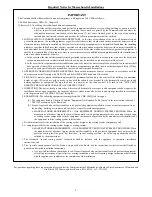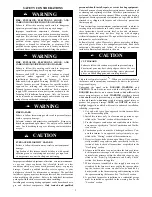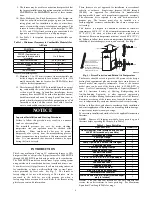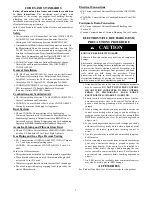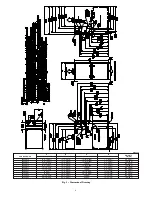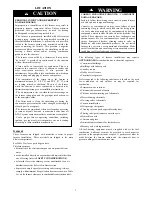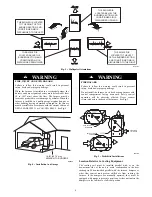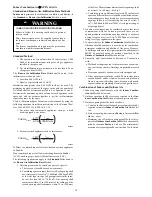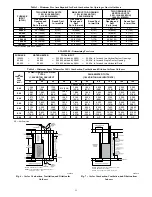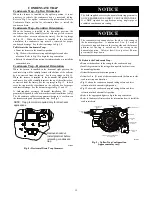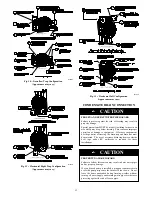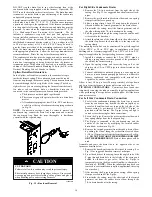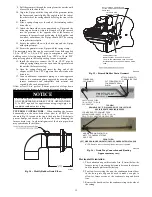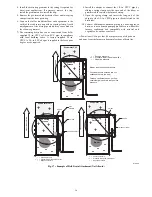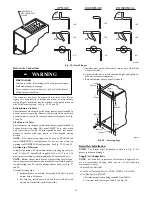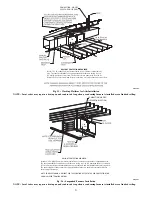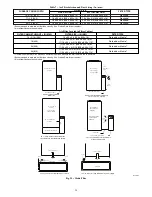
9
AIR FOR COMBUSTION AND
VENTILATION
Introduction
2--pipe Applications
When the furnace is installed as a 2-pipe furnace, no special
provisions for air for combustion are required. However, other gas
appliances installed in the space with the furnace may require
outside air for combustion. Follow the guidelines below to insure
that other gas appliances have sufficient air for combustion.
1--pipe Applications
When the furnace is installed as a 1-pipe furnace, it will be
necessary to insure there is adequate air for combustion. Other gas
appliances installed with the furnace may also require air for
combustion and ventilation in addition to the amount of
combustion air and ventilation air required for the furnace. Follow
the guidelines below to insure that the furnace and other gas
appliances have sufficient air for combustion.
Ventilated Combustion Air Applications
When the furnace is installed using the ventilated combustion air
option, the attic or crawlspace must freely communicate with the
outdoor to provide sufficient air for combustion. The combustion
air pipe cannot be terminated in attics or crawlspaces that use
ventilation fans designed to operate during the heating season. If
ventilation fans are present in these areas, the combustion air pipe
must terminate outdoors as a 2-Pipe system.
All air for combustion is piped directly to the furnace from a space
that is well ventilated with outdoor air (such as an attic, crawl space
or equipment closet) and the space is well isolated from the living
space or garage. In addition, other gas appliances installed in the
space with the furnace may require outside air for combustion.
Follow the guidelines below to insure that the roof or crawlspace
walls have sufficient free area to provide sufficient air for
combustion and ventilation for the furnaces. The guidelines below
can be used to insure that other gas appliances have sufficient air
for combustion.
Provisions for adequate combustion, ventilation, and dilution air
must be provided in accordance with:
S
U.S.A. Installations: Current edition of
Section 9.3 o
f the NFPA
54/ANSI Z223.1 , Air for Combustion and Ventilation and
applicable provisions of the local building codes.
S
Canada: Current edition of Part 8 of the CAN/CSA--B149.1,
Venting Systems and Air Supply for Appliances.
FURNACE CORROSION HAZARD
Failure to follow this caution may result in furnace damage.
Air for combustion must not be contaminated by halogen
compounds, which include fluoride, chloride, bromide, and
iodide. These elements can corrode heat exchangers and
shorten furnace life. Air contaminants are found in aerosol
sprays, detergents, bleaches, cleaning solvents, salts, air
fresheners, and other household products.
CAUTION
!
CARBON MONOXIDE POISONING HAZARD
Failure to follow this warning could result in personal
injury or death.
The operation of exhaust fans, kitchen ventilation fans,
clothes dryers, attic exhaust fans or fireplaces could create a
NEGATIVE PRESSURE CONDITION at the furnace.
Make--up air MUST be provided for the ventilation devices,
in addition to that required by the furnace. Refer to the
Carbon Monoxide Poisoning Hazard warning in the venting
section of these instructions to determine if an adequate
amount of make--up air is available.
!
WARNING
The requirements for combustion and ventilation air depend upon
whether or not the furnace is located in a space having a volume of
at least 50 cubic feet per 1,000 Btuh input rating for all gas
appliances installed in the space.
S
Spaces having less than 50 cubic feet per 1,000 Btuh (4.8 cubic
meters per kW) require the
Outdoor Combustion Air Method
.
S
Spaces having at least 50 cubic feet per 1,000 Btuh (4.8 cubic
meters per kW) may use the
Indoor Combustion Air,
Standard or Known Air Infiltration Method.
Outdoor Combustion Air Method
1. Provide the space with sufficient air for proper combustion,
ventilation, and dilution of flue gases using permanent hori-
zontal or vertical duct(s) or opening(s) directly communicat-
ing with the outdoors or spaces that freely communicate
with the outdoors.
2. Fig. 6 illustrates how to provide
TWO OUTDOOR
OPENINGS
, one inlet and one outlet combustion and vent-
ilation air opening, to the outdoors.
a. One opening
MUST
commence within 12 in. (300 mm)
of the ceiling and the second opening MUST commence
within 12 in. (300 mm) of the floor.
b. Size openings and ducts per Fig. 6 and Table 3.
c.
TWO HORIZONTAL DUCTS
require 1 sq. in. (645 sq.
mm) of free area per 2,000 Btuh (1,100 mm
2
/kW) of com-
bined input for all gas appliances in the space per Fig. 6 and
Table 3.
d.
TWO OPENINGS OR VERTICAL DUCTS
require 1
sq. in. (645 sq. mm) of free area per 4,000 Btuh (550
mm
2
/kW) for combined input of all gas appliances in the
space per Fig. 6 and Table 3.
3.
ONE OUTDOOR OPENING
requires:
a. 1 sq. in. (645 sq. mm) of free area per 3,000 Btuh (734
mm
2
/kW) for combined input of all gas appliances in the
space per Fig. 6 and Table 3.
b. Not less than the sum of the areas of all vent connectors in
the space.
The opening shall commence within 12 in. (300 mm) of the
ceiling. Appliances in the space shall have clearances of at least 1
in. (25 mm) from the sides and back and 6 in. (150 mm) from the
front. The opening shall directly communicate with the outdoors or
shall communicate through a vertical or horizontal duct to the
outdoors or spaces (crawl or attic) that freely communicate with the
outdoors.
Содержание 915SB
Страница 65: ...65 A190099 Fig 63 Service Label Information...
Страница 76: ...76 A190093 Fig 69 Troubleshooting Guide Cont...
Страница 77: ...77 344442 2 Rev C A190259 Fig 70 Wiring Diagram...


